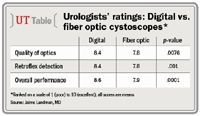Article
Flexible cystoscopes: Urologists prefer digital type
Author(s):
Results of a prospective study in which urologic surgeons at Columbia University Medical Center, New York, compared flexible fiber optic and digital cystoscopes show that with proper care, both types are durable for in-office applications.

"The digital flexible cystoscopes ostensibly offer superior optics and deflection, while maintaining excellent durability. Our prospective evaluation supports these claims, but surgeon evaluations and usage patterns indicate preferences for the digital cystoscopes," Dr. Okhunov said in his presentation at the AUA annual meeting in Chicago.
The digital cystoscopes studied were the ICN-0564 (Gyrus ACMI, Southborough, MA) and the CYF-V2 EndoEYE Cysto-Nephro videoscope (Olympus, Center Valley, PA). The fiber optic devices were the ACN-2 (Gyrus ACMI) and the CYF-5 Cysto-Fiberscope (Olympus). (Olympus completed its acquistion of Gyrus Group PLC in 2008.)
"The ratio of utilization provides a surrogate endpoint of user preference and demonstrates a trend favoring the distal sensor cystoscopes," said Dr. Landman, associate professor and director of minimally invasive surgery in Columbia's department of urology.
With the data pooled for each category of device, the mean operative time per case was nearly identical among those using the digital and fiber optic cystoscopes-4.5 and 4.6, respectively-and there were no significant differences between the fiber optic and digital cystoscopes in time needed to accomplish any specific task.
Strong preferences for digital
However, surgeon ratings recorded after each procedure using a 10-point scale (1=poor, 10=excellent) showed statistically significant differences that consistently favored the digital cystoscopes over the fiber optic devices in terms of better optics (8.4 vs. 7.8; p=.0076), retroflex deflection (8.4 vs. 7.8; p=.001), and overall performance (8.6 vs. 7.9; p=.0001).
Measurements of upward and downward deflection angles showed differences between manufacturers' data and the initially recorded measurements for all instruments as well as slight variations during the study, but with no significant deteriorations in performance.
Deflection rate measurements showed active deflection decreased over time with both the fiber optic and the digital instruments, although the changes were not significant.
Only two repairs, one for a fiber optic cystoscope and one for a digital scope, were documented during the course of the study, and while they were from the same manufacturer, the malfunctions were attributed to incorrect cystoscope handling or cleaning, Dr. Okhunov reported.
The devices used in the study were loaned by the manufacturers to the department of urology. Dr. Landman has served as an investigator for Gyrus ACMI.















